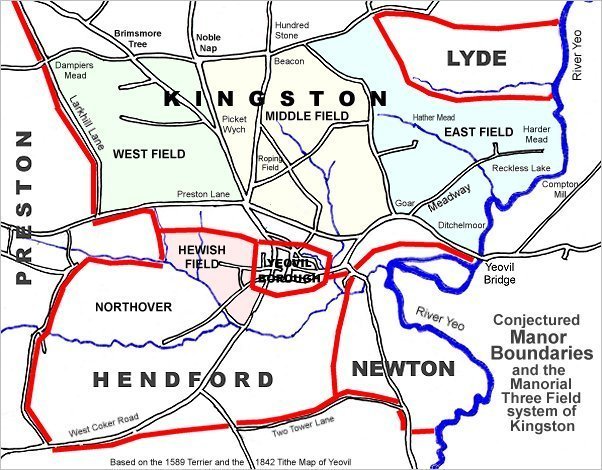Archer's Mead
Archer's Mead
Remnant of the medieval common field called Hewish Field
The great medieval field called Northover (see first map below) was later broken up and part of it became a large common field called Hewish, or Hewish Field, stretching from Ram Park in the north, the boundary with the parish of Preston Plucknett in the west, today's West Hendford in the south and roughly as far as today's Clarence Street in the east. The parcels comprising the former great common field called Hewish Field are shown shaded green in the 1842 Tithe Map below.
The name Huish, in its various spellings through time, derives from the Old English 'hiwisc' meaning a household.
On 1 July 1415 Thomas, Earl of Arundel, granted the advowson of Yeovil Rectory to Henry V with "two acres in the field called Huysh".
It was recorded that in 1611 St Leonard's Fair for rother cattle was held in "the field called Huishe in Hendford" - in this instance Hendford being the Manor of Hendford, not the road of that name. As a sidenote; the word 'rother' is an old Anglo-Saxon word for cattle. The rother cattle were long-horned, fleshy beasts prized for their meat, milk, hide and horn (see photo here).
An indenture of 1715 remarks on six acres of arable land "lying in a common field called Hewish in the tything of Hinford.... lately enclosed" - the words 'lately enclosed' being a good indication of when this common field began to be parcelled up. By the 1750s the division parcels of Hewish Field were more or less finalised as shown in the 1842 Tithe Map below.
One of these division parcels of the former common field was Archer's Mead (Parcel 607). The word 'mead' comes from the Old English 'maed'. Before grass seeds were obtainable this was the only hay land of the community. It usually consisted of land near streams since that was the only kind of land on which hay grew in any quantity.
The 1846 Tithe Apportionment recorded that Archer's Mead measured 3a 1r 15p and was used as meadow. The Apportionment noted that Archer's Mead was owned and occupied by Robert Bowering.
Archer's Mead was bounded on the north by the field access track known as Hewish Lane (today's Huish), to the west by a small field with cottages (Parcel 608 - owned and occupied by George Hallett), to the south by Hibbard's Orchard (Parcel 310) and by Priddle's Orchard (Parcel 606) to the east.
In the late 1930s, and interrupted by the Second World War, most of Richmond Road along with the houses and gardens on its western side was constructed on the former Archer's Mead. Most of the houses on the eastern side were constructed after the war. The very southern part of Richmond Road (the kinked bit) was built later as Hibbard's Orchard was acquired.
For details on historic land measurement (ie acres, roods and perches) click here.
maps & Aerial Photograph

This map, based on the descriptions in the 1589 Terrier and the 1846 Tithe Map of Yeovil shows the approximate boundaries of the Manors of Kingston and Hendford as well as the manorial three-field system used in Kingston.

TThis map is based on the 1842 Tithe Map with field names added from the 1846 Tithe Award. The area shaded light green was originally a large common field called Hewish Field that had been formed out of the earlier medieval field called Northover. By the time of the 1842 Tithe Map, shown here, Hewish Field had been further sub-divided into many parcels as shown.
Archer's Mead is left of centre.

The 1842 Tithe Map superimposed (roughly) over a modern street map showing where several modern roads, for example the rear gardens of the eastern side of Grove Avenue, follow former field boundaries.

The 1946 aerial photograph clearly shows Huish running along the top and West Hendford and the Crescent at bottom right. By this time Richmond Road, seen left of centre, had been built on Archer's Mead together with a couple of houses on the eastern side at the northern end. The remainder were constructed shortly after this photograph was taken.